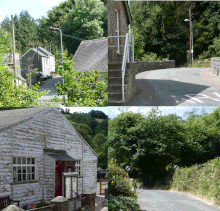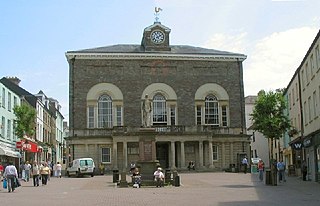
Carmarthenshire is a county in the south-west of Wales. The three largest towns are Llanelli, Carmarthen and Ammanford. Carmarthen is the county town and administrative centre. The county is known as the "Garden of Wales" and is also home to the National Botanic Garden of Wales.

Carmarthen is the county town of Carmarthenshire and a community in Wales, lying on the River Towy 8 miles (13 km) north of its estuary in Carmarthen Bay. The population was 14,185 in 2011, down from 15,854 in 2001, but gauged at 16,285 in 2019. It has a claim to be the oldest town in Wales – Old Carmarthen and New Carmarthen became one borough in 1546. It was the most populous borough in Wales in the 16th–18th centuries, described by William Camden as "chief citie of the country". Growth stagnated by the mid-19th century as new settlements developed in the South Wales Coalfield.
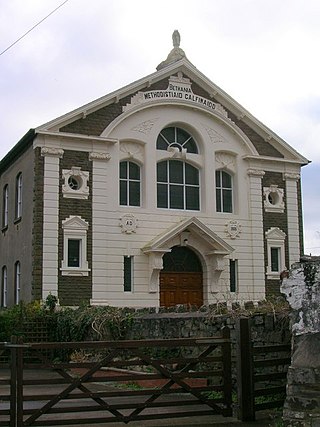
Glanamman is a mining village in the valley of the River Amman in Carmarthenshire, Wales. Glanamman has long been a stronghold of the Welsh language; village life is largely conducted in Welsh. Like the neighbouring village of Garnant it experienced a coal-mining boom in the 19th and early 20th centuries, but the last big colliery closed in 1947 and coal has been extracted fitfully since then.
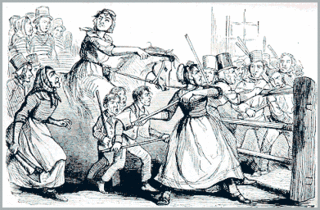
The Rebecca Riots took place between 1839 and 1843 in West and Mid Wales. They were a series of protests undertaken by local farmers and agricultural workers in response to levels of taxation. The rioters, often men dressed as women, took their actions against toll-gates, as they were tangible representations of taxes and tolls. The rioters went by the name of 'Merched Beca' which translates directly from Welsh as Rebecca's Daughters. The riots ceased prior to 1844 due to several factors, including increased troop levels, a desire by the protestors to avoid violence, and the appearance of criminal groups using the guise of the biblical character Rebecca for their own purposes. In 1844 an Act of Parliament to consolidate and amend the laws relating to turnpike trusts in Wales was passed.

Carmarthen West and South Pembrokeshire is a constituency of the House of Commons of the Parliament of the United Kingdom. It elects one Member of Parliament (MP) by the first past the post system of election.

Trelech is a village in the parish of Tre-lech a'r Betws, Carmarthenshire, in south-west Wales. It is also the name of the community. Trelech is located some 10 miles north-west of Carmarthen and 6.5 miles south of Newcastle Emlyn.

Abernant is a hamlet and community in Carmarthenshire, Wales. The population taken at the 2011 census was 297.

Pencader is a small village in Carmarthenshire, Wales, in the community of Llanfihangel-ar-Arth. It is located around 3 miles (5 km) south-east of Llandysul and 6.5 miles (10 km) south-west of Llanybydder, in the valley of the Gwen brook, shortly before the confluence with the River Talog, to form the River Tyweli.

Llannon is a small village, community and electoral ward in the county of Carmarthenshire, Wales. It is located on the A476 road 11 mi (18 km) south east of the county town, Carmarthen, between Tumble and Swiss Valley.
Brechfa, situated between Llandeilo and Carmarthen in the county of Carmarthenshire, Wales, is a village that has existed since the 6th century at the top of the Cothi Valley. Brechfa village is set in countryside, as well as being located by the Brechfa Forest
This article is about the particular significance of the year 1843 to Wales and its people.
Cilymaenllwyd is a community on the extreme northwest of Carmarthenshire in Wales. The community population at the 2011 census was 742. It lies about 25 miles (40 km) west of Carmarthen, 12 miles (19 km) southeast of Fishguard and 15 miles (24 km) northeast of Haverfordwest. The A478 road runs through the community.
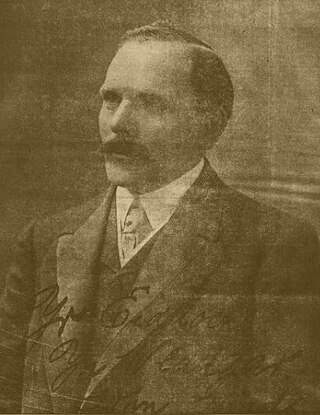
John Hinds was a Welsh businessman and politician. At the December 1910 general election Hinds was chosen as the Liberal candidate for the seat of West Carmarthenshire, holding the seat until its abolition in 1918.

Cynwyl Elfed is a village and community in the county of Carmarthenshire, Wales. The community includes the villages of Cynwyl Elfed, Blaenycoed and Cwmduad. It is situated about 5 miles (8.0 km) north of Carmarthen and had a population of 953 in 2001, increasing to 1,044 at the 2011 Census.
Newchurch and Merthyr is a community located in Carmarthenshire, Wales including the villages of Newchurch and Merthyr. The community population at the 2011 census was 676.

Llangynog is a village and community located in Carmarthenshire, Wales, the main settlement of which was once called ‘Ebenezer’village. It is bordered by the communities of: Newchurch and Merthyr; Carmarthen; Llangain; Llansteffan; Laugharne Township; and St Clears, all being in Carmarthenshire. The population at the 2011 census was 492.
David Davies, also known as Dai'r Cantwr, was a Welsh poet and lay-preacher. He was convicted and sentenced to transportation to Australia for his actions during the Rebecca Riots.

Known as The Garden of Wales, Carmarthenshire is a county of rich, fertile farmland and productive seas and estuaries, that give it a range of foods that motivate many home cooks and restaurateurs. There is a local tradition in brewing, milling, gathering shellfish from the coasts and meat production. Carmarthenshire has been described by The Daily Telegraph as a "worthwhile destination for foodies" with the county having a modest matter of fact excellence. Carmarthenshire has ambitions to become the premier food-producing county of Wales, based on its strong reputation for first-class products. and Carmarthenshire County Council produces its own on-line and hard-copy recipe book called Taste from Carmarthenshire, for those interested in learning more about the county's cuisine.

Carmarthen Guildhall is a municipal structure in Guildhall Square, Carmarthen, Wales. The guildhall, which was the headquarters of Carmarthen Borough Council, is a Grade I listed building.
Trelech is the name of an electoral ward for Carmarthenshire County Council in Carmarthenshire, Wales. It is represented by one county councillor.
